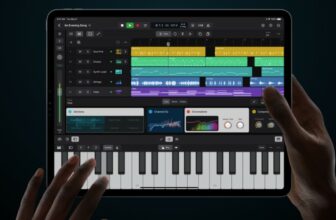The Differences between VST, VST3, AU, and AAX (Audio Plugin Formats)

VST stands for Virtual Studio Technology and it’s the most widely used audio plugin-in software interface in the world. VST3 is the technology’s latest installment. AU and AAX are also audio plugin-in architectures but they’re used exclusively in, respectively, Apple’s macOS and iOS and Pro Tools.
When you’re installing a new audio plug-in in your device, you’ve probably stumbled upon the terms VST, VST3, AU, and AAX. And while you may have been tempted to install all of them, the truth is that, in most cases, you only needed one.
Understanding the differences between these audio plug-in formats is crucial for saving some space on your computer and making better decisions in the future. But what is it that sets them apart? And how can you know which ones you should be ignoring?
Contents
What’s a VST?
VST stands for Virtual Studio Technology and is the most common audio plug-in architecture in the world.
VST was developed by Steinberg in 1996 and has since become the gold standard in music production. VST is a native plug-in, meaning it relies on your computer’s CPU. Different types of VST plug-ins include instruments, effects, and MIDI effects (you can learn more about them here).
Pretty much every digital audio workstation (DAW) in the world supports VST plug-ins. Pro Tools, which relies on its own proprietary audio plug-in format, is the one major exception. Considering macOS and iOS also have their audio plug-in format, VST plug-ins are first and foremost designed for Windows users.
What’s VST3?
VST3 is the latest installment of the Virtual Studio Technology developed by Steinberg and it’s stronger, performance-wise, because it only uses your computer’s processing power if it has to.
Unlike VST, VST3 is not active whenever its functions are not being used, which helps to save a lot of CPU usage.
If you have a project loaded with 15 VST instruments, they’re overloading your CPU even if you’re monitoring a section of the song in which they’re not being used. If you have a project loaded with 15 VST3 instruments but you’re monitoring a section of the song in which none is being used, then your CPU will not be dealing with any of them at that moment.
While there are several other updates to VST3 that are worth exploring, VST3’s more-efficient processing is, crucially, what makes it better than its predecessor.
Should you always use VST3?
You should always use VST3, assuming you’re working with a DAW that supports VST3. Most modern DAWs do so, but it’s always important to check before throwing your entire VST folder in the trash. VST3 is the future, so it’s probably time for you to start making the transition from VST to VST3.
What’s AU?
AU stands for Audio Units and it’s Apple’s system-level audio plug-in architecture, exclusive to macOS and iOS. Similar to VST, AU is a native plug-in. While it’s possible to use VSTs inside Apple’s operative systems, there’s no reason for doing so if you also have access to the more specific and efficient AU audio plug-ins.
Detailing the technical aspects that make VST and AU technology different is not pertinent from a music-production point of view. To sum it up, VST is the best audio plug-in format for Windows users, whereas AU is the best audio plug-in format for Mac users.
If you know anything about Apple, you probably know they’re not big fans of going with the gold standard – unless, of course, it was made by them! Needless to say, they decided not to adopt VST and instead focus on creating their Mac-exclusive audio plug-in architecture. That’s AU in a nutshell.
What’s AAX?
AAX stands for Avid Audio eXtension and it’s an audio plug-in format created by Avid Technology. AAX is fundamentally different from VST and AU because it’s both a native and DSP-powered plug-in (more on DSP later). This means that AAX can be used more efficiently with the help of third-party hardware such as Pro Tools’s Carbon audio interface.
The other thing that makes AAX different from VST and AU is the fact that it’s exclusive to Pro Tools. If you’re working inside Ableton Live, Logic Pro, or any other DAW, it simply doesn’t make sense to install AAX files on your computer. If Pro Tools is your music program of choice, it would be illogical not to do so.
AAX is the successor of two other Pro Tools-specific audio plug-in architectures developed by Avid Technology: RTAS and TDM (more on that below). Irrelevant technological specifications aside, AAX is the go-to audio plug-in format for Pro Tools users, in the same way that VST is the gold standard for Windows users and that AU is the best option for Mac users.
What are RTAS and TDM?
Unless you’ve started making music in the last two years or so, you’ve probably also stumbled upon the audio plug-in formats RTAS and TDM. These were both developed by Avid Technology and they can be fairly considered obsolete since the creation of AAX.
RTAS stands for Real-Time AudioSuite and TDM stands for Time-division Multiplexing. Both were exclusively used inside Pro Tools. RTAS was the DAW’s native audio plug-in format, whereas TDM was the DAW’s DSP-powered audio plug-in format. They were both replaced by AAX, which can perform both functions simultaneously.
Which audio plug-in format should you install?
- Are you a Windows user making music on a program that supports VST3? Always install VST3.
- Are you a Windows user making music on a program that only supports VST? Install both VST and VST3. You’ll thank me later, once your DAW of choice starts supporting VST3.
- Are you a Mac user? Always install AU.
- Are you making music on Pro Tools? Always install AAX. If you’re using other DAWs, it’s a good idea to also install a VST3 or AU file, depending on your computer’s operating system.
- Are you trying to use a plug-in that’s only available in RTAS or TDM format? This is the only scenario in which I’d recommend installing RTAS or TDM.
Native vs. DSP Plug-ins
While it’s important to know the differences between VST, VST3, AU, and AAX audio plugin-ins, it’s important to understand what a plug-in is and what’s the difference between native and DSP plugin-ins.
A plug-in is merely computer software that runs inside another computer software. Audio plug-ins are simply add-ons to music programs. In other words, plugin-ins are software that cannot run by itself but needs a specific host program.
There are many audio plug-in formats, but they’re divided into two fundamental categories: native plug-ins and DSP plug-ins. Native plug-ins are powered solely by a computer’s CPU, while DSP plug-ins are powered by a separate processor, whether it’s a card processor or an audio interface.
The advantage of using DSP plug-ins is that you can save your computer’s CPU some work, which is great from a performance standpoint. However, you should have no issues using native plug-ins (which are far more common), especially if your computer is powered by a good CPU for music production.
Summary
VST stands for Virtual Studio Technology. VST3, AU, and AAX are all different audio plug-in formats with their specific purposes. VST3 is the best audio plug-in format for Windows users, while AU is the best option for Mac users. AAX is exclusive to Pro Tools and is both a native and DSP-powered plug-in. RTAS and TDM are both obsolete formats that were replaced by AAX.
When choosing which audio plug-in format to install, you should always consider the type of DAW you’re using and your operating system.






